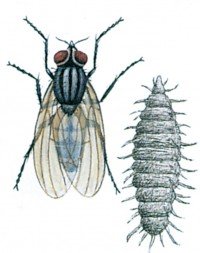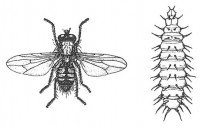Latin: Fannia canicularis.


The lesser house fly is the typical house fly. It is 5 -7 mm. The males of this species can be seen in a tireless bouncing dance around lamps or other things hanging down from the ceiling. The lesser house fly lays its eggs one by one in very moist, decaying substances, for example, in moist manure or sink drains.
The larvae do not look like ordinary fly larvae. They are flat with a rough, grainy skin and longitudinal rows of thread-shaped, spiny appendages on the joints. The lesser house fly larvae move slowly and are difficult to spot because whatever they live in, sticks to its outgrowths. The pupa resembles the larva much. At 18 ° C development from egg to adult lasts 21 days, and at slightly higher temperatures, 21-26 ° C, it is, not significantly lower, 18 days.
Individual lesser house flies, which may live in birds’ nests, dog excrement, etc., can be found everywhere. Major invasions can almost always be traced back to a chicken or a mink farm. The larvae thrive in chicken or mink manure.




